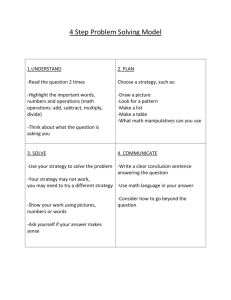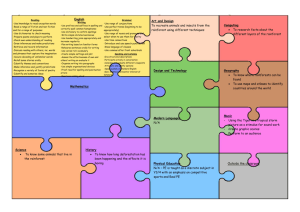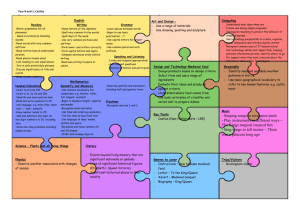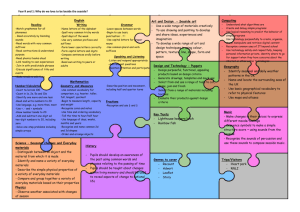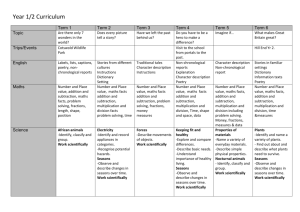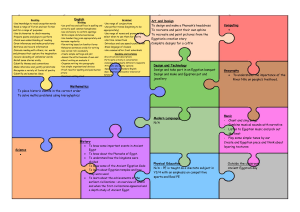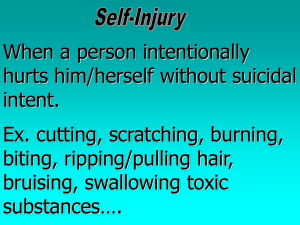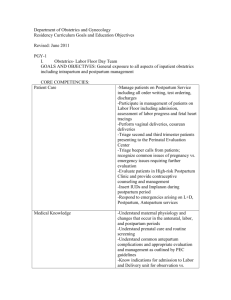curriculum planning map Y3/4
advertisement
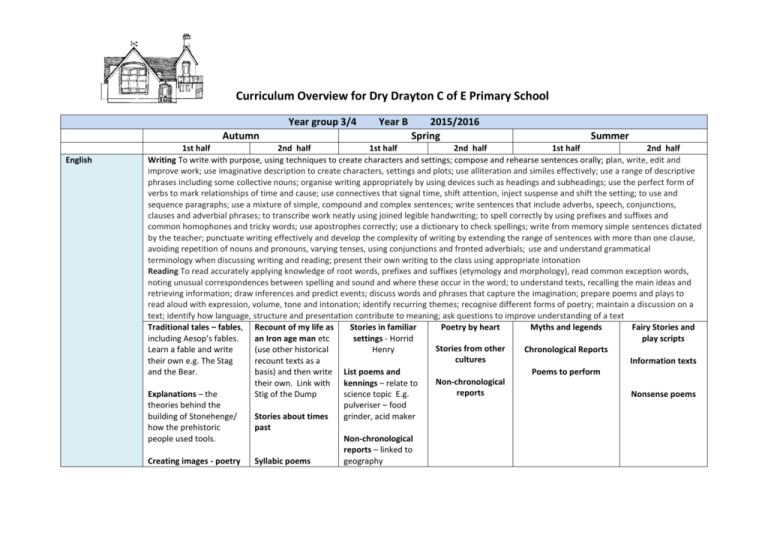
Curriculum Overview for Dry Drayton C of E Primary School Year group 3/4 Autumn English Year B 2015/2016 Spring Summer 1st half 2nd half 1st half 2nd half 1st half 2nd half Writing To write with purpose, using techniques to create characters and settings; compose and rehearse sentences orally; plan, write, edit and improve work; use imaginative description to create characters, settings and plots; use alliteration and similes effectively; use a range of descriptive phrases including some collective nouns; organise writing appropriately by using devices such as headings and subheadings; use the perfect form of verbs to mark relationships of time and cause; use connectives that signal time, shift attention, inject suspense and shift the setting; to use and sequence paragraphs; use a mixture of simple, compound and complex sentences; write sentences that include adverbs, speech, conjunctions, clauses and adverbial phrases; to transcribe work neatly using joined legible handwriting; to spell correctly by using prefixes and suffixes and common homophones and tricky words; use apostrophes correctly; use a dictionary to check spellings; write from memory simple sentences dictated by the teacher; punctuate writing effectively and develop the complexity of writing by extending the range of sentences with more than one clause, avoiding repetition of nouns and pronouns, varying tenses, using conjunctions and fronted adverbials; use and understand grammatical terminology when discussing writing and reading; present their own writing to the class using appropriate intonation Reading To read accurately applying knowledge of root words, prefixes and suffixes (etymology and morphology), read common exception words, noting unusual correspondences between spelling and sound and where these occur in the word; to understand texts, recalling the main ideas and retrieving information; draw inferences and predict events; discuss words and phrases that capture the imagination; prepare poems and plays to read aloud with expression, volume, tone and intonation; identify recurring themes; recognise different forms of poetry; maintain a discussion on a text; identify how language, structure and presentation contribute to meaning; ask questions to improve understanding of a text Traditional tales – fables, Recount of my life as Stories in familiar Poetry by heart Myths and legends Fairy Stories and including Aesop’s fables. an Iron age man etc settings - Horrid play scripts Stories from other Learn a fable and write (use other historical Henry Chronological Reports cultures their own e.g. The Stag recount texts as a Information texts and the Bear. basis) and then write List poems and Poems to perform Non-chronological their own. Link with kennings – relate to reports Explanations – the Stig of the Dump science topic E.g. Nonsense poems theories behind the pulveriser – food building of Stonehenge/ Stories about times grinder, acid maker how the prehistoric past people used tools. Non-chronological reports – linked to Creating images - poetry Syllabic poems geography Mathematics Science Count and calculate in increasingly complex contexts, including those that cannot be experienced first -hand; rigorously apply mathematical knowledge across the curriculum, in particular in science, technology and computing, deepen conceptual understanding of mathematics by frequent repetition and extension of key concepts in a range of engaging and purposeful contexts; explore numbers and place value so as to read and understand the value of all numbers; add and subtract using efficient mental and formal written methods; multiply and divide using efficient mental and formal written methods; use the properties of shapes and angles in increasingly complex and practical contexts, including in construction and engineering contexts; describe position, direction and movement in increasingly precise ways; use and apply measures to increasingly complex contexts, gather, organise and interrogate data; understand the practical value of using algebra Place value and money Addition and Place value Addition and Place value and money Shape, symmetry Addition and subtraction subtraction Addition and subtraction Addition and subtraction and angles Shape and symmetry Time and data subtraction Time and Multiplication and Data and measures Multiplication and Multiplication and Measures and data timetables, Codivision Fractions and division division Fractions and ordinates, position Area, perimeter and codecimals Fractions decimals and direction ordinates Length Place value and Multiplication and Measurement and data Addition and division division Addition, subtraction and subtraction Negative numbers Fractions and money Time and graphs decimals Place value and The four operations: sequences problem solving Plants • Identify and describe the functions of different parts of flowering plants: roots, stem/trunk, leaves and flowers • Explore the requirements of plants for life and growth (air, light, water, nutrients from soil, and room to grow) and how they vary from plant to plant • Investigate the way in which water is transported within plants • Explore the part that flowers play in the life Forces and magnets Animals, including humans Compare how things move on different surfaces. • Notice that some forces need contact between two objects, but magnetic forces can act at a distance • Observe how magnets attract or repel each other and attract some materials and not others Identify that animals, including humans, need the right types and amount of nutrition, and that they cannot make their own food; they get nutrition from what they eat. • Identify that humans and some other animals have skeletons and muscles for support, protection and Light Rocks • Recognise that they need light in order to see things and that dark is the absence of light • Notice that light is reflected from surfaces • Recognise that light from the sun can be dangerous and that there are ways to protect their eyes • Recognise that shadows are Compare and group together different kinds of rocks on the basis of their appearance and simple physical properties. • Describe in simple terms how fossils are formed when things that have lived are trapped within rock • Recognise that soils are made from rocks and organic matter. Computing cycle of flowering plants, including pollination, seed formation and seed dispersal. • Compare and group together a variety of everyday materials on the basis of whether they are attracted to a magnet, and identify some magnetic materials. • Describe magnets as having two poles. • Predict whether two magnets will attract or repel each other, depending on which poles are facing. movement. formed when the light from a light source is blocked by a solid object. • Find patterns in the way that the size of shadows change. Scratch coding – can we create our own prehistoric game? -Use screen coordinates to control movement. -Set the appearance of objects and create. sequences of changes -Create and edit sounds. Control when they are heard, their volume, duration and rests. -Draw and control the shade of pens. -Specify conditions to trigger events. -Use IF THEN conditions to control events or Creating a PowerPoint presentation of My Life as an Iron Age person -Use advanced features of applications and devices to communicate ideas. Staying Safe Online Using Google maps and satellites to show terrain and development in different parts of the world Setting up a blog to link with our Spanish partner school -Contribute to blogs moderated by teachers -Understand the risks posed by online communications. -Understand that hurtful comments made online are the same as bullying. -Understanding how online services work. Scratch coding objectives as Autumn 1 plus -Use variables to store a value. -Use the functions define, set, change, show and hide to control the variables. -use the reporter Use ipads or video cameras to film performance poetry -Use advanced features of applications and devices to communicate ideas. Use a programme such as Minecraft/imagine super logo to build a virtual pyramid. Set the appearance of objects and use advanced features of applications. Creating our own databases -Devise and construct databases using applications designed for this purpose. Art and Design Design and Technology objects. -Create conditions for actions by sensing proximity or waiting for a user input such as responses to a question or proximity to a specified colour. -Learn about the risks posed by online communications. -Use plants as an inspiration for artwork. -Develop and share ideas in a sketchbook. Improve mastery of sketching technique by drawing from life. -Use shading to show light and shadow. -Use our Stone Age topic as inspiration for cave painting. -Use brush and finger techniques to produce shapes, textures, patterns and lines. -Replicate some of the techniques used by prehistoric man. Looking at the purpose and design of prehistoric tools and make our own. -Research prehistoric implements and develop design criteria to make a replica tool or weapon. -Use tools and equipment to perform practical tasks such as cutting, shaping and joining. Understand how to operators; () + () and () – () and () * () to perform calculations ( check this one) Mummies and sarcophagi -create 3D shapes from a variety of materials to create recognisable forms -add materials to provide interesting detail -use paint or collage to create realistic and striking effects Healthy snack preparation: -Understand and apply the principles of a healthy and varied diet. -Prepare and cook a savoury snack or dish using a cooking technique, such as peeling, cutting, chopping, mixing and heating. Construct a pyramid - Select from and use a wider range of tools and equipment to perform practical tasks, such as cutting, shaping, joining and finishing, accurately. -Apply their understanding of how to strengthen, stiffen and reinforce more complex structures. -Understand how key events and individuals in design and technology have helped shape the Music Skills taught over Y3/4 strengthen more world. complex structures Evaluate their own product. To perform: Sing from memory with accurate pitch. Sing in tune. Maintain a simple part within a group. Pronounce words within a song clearly. Show control of voice. Play notes on an instrument with care so that they are clear. Perform with control and awareness of others. To compose: Compose and perform melodic songs. Use sound to create abstract effects. Create repeated patterns with a range of instruments. Create accompaniments for tunes. Use drones as accompaniments. Choose, order, combine and control sounds to create an effect. Use digital technologies to compose pieces of music. To transcribe: Devise non-standard symbols to indicate when to play and rest. Recognise the notes EGBDF and FACE on the musical stave. Recognise the symbols for a minim, crotchet and semibreve and say how many beats they represent. To describe music: Use the terms: duration, timbre, pitch, beat, tempo, texture and use of silence to describe music. Evaluate music using musical vocabulary to identify areas of likes and dislikes. Understand layers of sounds and discuss their effect on mood and feelings. To listen to music: Appreciate and understand a wide range of high-quality live and recorded music from different traditions and from great musicians and composers. Develop an understanding of the history of music. Plants/ Growing to link Playing the recorder Dragon Scales Playing the Amazing Egyptians to link KS2 Production with Science (1) Exploring melodies recorder (2) with History and scales Singing and Listen to music with Play with clarity and Learning a verse and performing with increasing layers of accuracy. Composing and Embedding and chorus song. confidence. To sing sound. Crescendo. Perform with control performing developing Understanding layers in (including ‘Morning’ and ‘Hall of the and awareness of melodies. transcription and musical structure. harmonies) with Mountain King’ from Peer others. Exploring timbre. performance skills Using instruments, accuracy, Gynt Suite by Greig Begin to recognise from previous combine 4 parts to create expressively and in Compose by layering and notes on the stave learning. a layered performance. tune. transcribe using graphic Recognise rhythmic Perform with scores music describing notation – notes for controlled breathing the growth of different different lengths of and timing. types of plant. sound. Physical Education Outdoor Adventurous Activity Understand the need to show accomplishment in managing risks. • Show an ability to both lead and form part of a team. • Support others and seek support if required when the situation dictates. • Show resilience when plans do not work and initiative to try new ways of working. • Use maps, compasses and digital devices to orientate themselves. • Remain aware of changing conditions and change plans if necessary. Games – Ball Handling Skills See games objectives in Ball on the Ground Gymnastics Patterns and pathways • Plan, perform and repeat sequences. • Move in a clear, fluent and expressive manner. • Refine movements into sequences. • Show changes of direction, speed and level during a performance. • Travel in a variety of ways, including flight, by transferring weight to generate power in movements. • Show a kinesthetic sense in order to improve the placement and alignment of body parts (e.g. in balances experiment to find out how to get the centre of gravity successfully over base and organise body parts to create an interesting body shape). • Swing and hang Gymnastics – principles of balance See gymnastics objectives in patterns and pathways Dance – cold places • Plan, perform and repeat sequences. • Move in a clear, fluent and expressive manner. • Refine movements into sequences. • Create dances and movements that convey a definite idea. • Change speed and levels within a performance. • Develop physical strength and suppleness by practising moves and stretching. Games – Ball on the Ground Throw and catch with control and accuracy. • Strike a ball and field with control. • Choose appropriate tactics to cause problems for the opposition. • Follow the rules of the game and play fairly. • Maintain possession of a ball (with, e.g. feet, a hockey stick or hands). • Pass to team mates at appropriate times. • Lead others and act as a respectful team member. Gymnastics – curling and stretching Games – Striking and Fielding See games objectives in Ball on the Ground Dance – Ancient Egyptians See Dance objectives as earlier Athletics Sprint over a short distance up to 60 metres. • Run over a longer distance, conserving energy in order to sustain performance. • Use a range of throwing techniques (such as under arm, over arm). • Throw with accuracy to hit a target or cover a distance. • Jump in a number of ways, using a run up where appropriate. • Compete with others and aim to improve personal best performances. Games – net games See games objectives in Ball on the Ground from equipment safely (using hands). Dance – Stone age man! See Dance objectives in cold places Myself and my Relationships 11,12 Family and Friends Anti-Bullying See gymnastics objectives in patterns and pathways PSHE Citizenship 8 Rights, Rules and Responsibilities Religious Education Understand beliefs and teachings by learning the key teachings and beliefs of a religion, referring to religious figures and holy books to explain answers; understand practices and lifestyles and identify religious artefacts and explain how and why they are used; describe religious buildings and explain how they are used; explain some of the religious practices of both clerics and individuals; understand how beliefs are conveyed and identify religious symbolism in literature and the arts; to reflect upon their own beliefs and show an understanding that personal experiences and feelings influence attitudes and actions, give some reasons why religious figures may have acted as they did and ask questions that have no universally agreed answers; understand values and describe how some of the values held by communities or individuals affect behaviour and actions; discuss and give opinions on stories involving moral dilemmas Christianity - Why pray? Christianity – Why Judaism – What is important for Jews about Christian Worship – How and why are churches do people go on being part of God’s family? different? pilgrimages? Spanish - To learn basic greetings and giving your name. To understand and recall orally the numbers 1-10. To ask how old someone is and give own age. To learn some key classroom language. To learn the days of the week. To learn numbers 11 – 31. To learn the months of the year. To ask and answer 'What date is it today?' To learn the names of the seasons. Healthy and Safer Lifestyles 15 Drug Education Visit from Life Education Bus - Economic Wellbeing 2 Financial capability Healthy and Safer Lifestyles 16 Personal Safety To learn nouns for different fruit. To revise the names of the days of the week. To learn food nouns from the Hungry Caterpillar story. To listen to and understand a Spanish story. To develop confidence and memory by retelling the HC story. To use knowledge of colours to create a butterfly. Healthy and Safer Lifestyles 17 Sex and Relationship education - Myself and My Relationships 13 Managing Change Ordering food in a café: To ask 'What would you like?' and respond 'I would like'. In a café - role plays: To ask / answer from memory. To write individual words from memory. To perform and record their group café dialogues. - History To join in with a Spanish song. To learn how to ask for and say your birthday. To sing ‘Happy Birthday’ in Spanish. To listen and follow a video clip with unfamiliar vocabulary. To use language of days, dates, and celebrations to make a birthday party invitation. To learn about a typical celebratory custom from Mexico: Making a piñata. To make a Christmas card. Stone Age and Bronze Age Britain Bronze Age, Iron Age Britain - Investigate and interpret the past. - Use evidence to ask questions and find answers to questions about the past, focusing on the tools and homes of prehistoric peoples. -Use more than one source of evidence for historical enquiry in order to gain a more accurate understanding of history. -Understand chronology and place events, artefacts and historical figures on a time line using dates. - Use literacy, numeracy -Communicate historically by using appropriate historical vocabulary such dates, eras, dates and chronology. -Build an overview of world history by gaining a broad overview of life in Britain in ancient times. -Describe the characteristic features of the past, including ideas, beliefs, attitudes and experiences of men, women and children. - To learn the adjectives of colour. To use knowledge of colours to create a butterfly. Ancient Egypt – the achievements of early civilisations Ancient Egypt (cont’d) -Investigate and interpret the past – use evidence to ask questions and find answers to questions. -Understand chronology and place events, artefacts and historical figures on a time line using dates. - Use literacy, numeracy and computing skills in order to communicate information about the past. -Communicate historically. -Build an overview of world history. -Describe the characteristic features of the past, including ideas, beliefs, attitudes and experiences of men, women and children. -Describe the social, ethnic, cultural or religious diversity of past society. and computing skills in order to communicate information about the past. Geography A region of UK – human and physical geography, land use -Identify key geographical features of the countries of the United Kingdom, and show an understanding of how some of these aspects have changed over time. -Understand geographical similarities and differences through the study of human and physical geography of a region or area of the United Kingdom. - Describe and understand key aspects of human geography, including: settlements, land use, economic activity including trade. - Locate the world’s countries, with a focus on Europe and countries of particular interest to pupils. Types of settlement - Describe and understand key aspects of human geography, including: settlements, land use, economic activity including trade. - Use the eight points of a compass, fourfigure grid references, symbols and keys (including the use of Ordnance Survey maps) to build knowledge of the United Kingdom and the world. - Use fieldwork to observe, measure and record the human and physical features in the local area using a range of methods, including sketch maps, plans and graphs and digital technologies.
